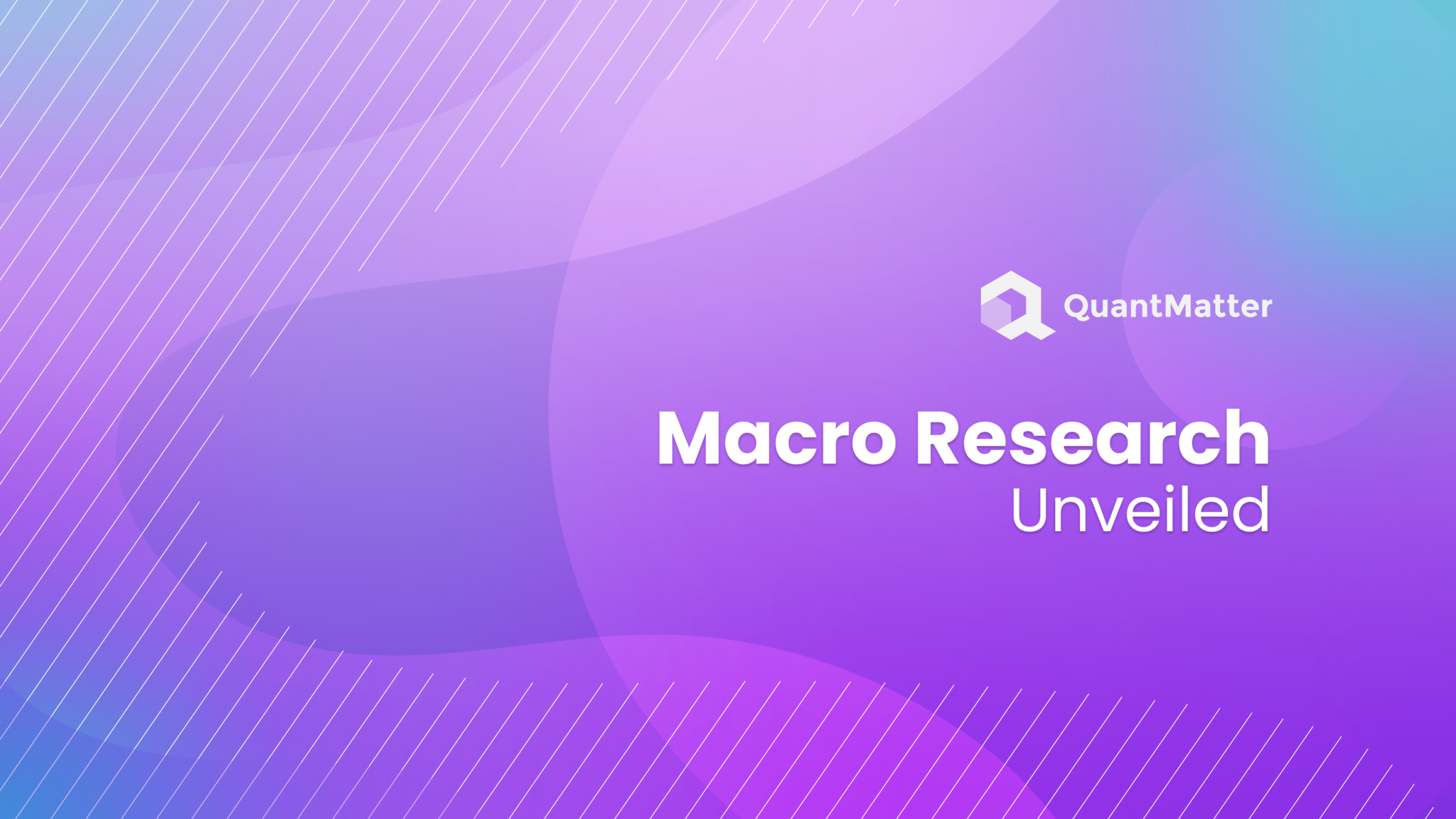
Macro research, often referred to as macroeconomic research, is far more than just an academic exercise; it’s a dynamic and indispensable discipline that occupies a central place in our understanding of the intricate economic landscape. This multifaceted field delves deep into the intricate web of economic indicators, variables, and factors that collectively shape the economic performance of nations and the global economy as a whole.
In this comprehensive exploration, we will embark on a journey through the vast realm of macro research, unveiling its profound significance, the diverse methodologies it employs, and the multitude of perspectives it offers to decision-makers, from individuals to governments and corporations. Our journey will reveal how macro research serves as both a compass and a tool, enabling us to navigate the complex seas of economics, make informed decisions, and steer our ships toward prosperity.
The Significance of Macro Research

Macro research, often referred to as macroeconomic research, stands as the intellectual ability to decipher the intricate web of economic forces unfolds on a grand scale. This sophisticated field is not merely an academic exercise; it is a dynamic, real-world compass that guides our understanding of economic phenomena, governmental policies, and their impacts on the businesses we run, the investments we make, and the daily lives we lead.
The depth of its significance cannot be overstated; it is nothing short of an essential component within the intricate web of our global economic ecosystem. Here’s an even more in-depth exploration of why macro research is not just important but undeniably essential.
– Economic Forecasting
At its very core, macro research serves as a potent economic weather forecasting system. It empowers us with the ability to predict and anticipate economic trends with a level of precision that is indispensable for businesses, governments, and individuals alike.
Take, for instance, the invaluable insights it provides concerning impending inflationary pressures, shifts in unemployment rates, and the trajectory of GDP growth. Armed with these forecasts, businesses can chart their courses with confidence, making informed decisions about resource allocation and developing strategies that seamlessly align with the prevailing economic conditions.
– Policy Implications
The decisions made by governments and central banks echo through the vast expanse of the economic landscape. These decisions wield influence over critical variables such as interest rates, taxation policies, and international trade regulations, shaping the very terrain upon which businesses operate and affecting the financial well-being of individual citizens.
Macro research is aiding policymakers as they navigate economic choices. It provides the insights necessary for informed decisions that have far-reaching ramifications. Without the foundation of macroeconomic research, the formulation of these policies would be less effective.
Also Read: Market Making 101: Strategies for Efficient Trading
– Risk Management
The comprehension of macroeconomic indicators is not a luxury; it’s a necessity for effective risk management. Both individuals and corporations rely on these insights to safeguard against financial perils. The knowledge of currency fluctuations, interest rate changes, and other economic indicators empowers them to proactively manage their risks.
This understanding serves as a protective shield in an unpredictable financial environment, ensuring that businesses remain resilient and individuals can safeguard their financial stability, regardless of the economic climate.
– Investment Decisions
Macro research serves the path to informed decisions. Investors, whether seasoned professionals or newcomers to the financial arena, depend heavily on macro research. It provides them with the tools to gauge the overall health of an economy, offering a roadmap for making calculated decisions regarding asset allocation. Whether it’s choosing between stocks, bonds, real estate, or commodities, the insights derived from macro research can be the key to achieving financial success.
Example of Macro Research
Macro research is the keystone of sound economic decision-making, transcending the confines of academia to influence and shape real-world outcomes. It is not a mere intellectual pursuit but a practical tool that enables us to understand and navigate the complexities of the global economy. Without macro research, we would be left adrift in an uncertain and unpredictable economic world, unable to make the informed decisions that underpin our prosperity and well-being.
One of the most prominent instances was during the Great Recession in 2008. Macro research played a pivotal role in guiding policymakers through the global financial crisis. It informed decisions such as bank bailouts, monetary policy adjustments, and fiscal stimulus packages. These measures were designed to stabilize financial markets, prevent a deeper recession, and restore economic growth.
In the aftermath of the 2008 financial crisis, central banks worldwide, including the Federal Reserve in the United States, implemented quantitative easing (QE) programs. These unconventional monetary policies were rooted in macroeconomic research that indicated traditional interest rate adjustments might not be sufficient to stimulate economic growth. QE aimed to lower long-term interest rates, encourage borrowing and investment, and combat deflationary pressures.
Macroeconomic research informs inflation targeting strategies for central banks. It helps in setting and adjusting inflation targets, which guide decisions about interest rates and monetary policy actions aimed at achieving and maintaining price stability.
5 Methods of Macro Research

Macro research, in its multifaceted nature, serves as a dynamic and vital tool in comprehending the intricate world of economics. The blend of various methodologies, each with its unique strengths, forms the very foundation upon which we build our understanding of macroeconomic dynamics.
Macro research is a multidimensional field that combines the precision of statistical analysis, the richness of historical context, the foresight of econometric modeling, and the human touch of qualitative research. It is a dynamic, multifaceted approach that forms the cornerstone of our understanding of macroeconomics. Let’s delve even deeper into these diverse methods and their far-reaching implications.
1. Statistical Analysis
Statistical techniques in macro research are like a magnifying glass that helps us dissect and decipher economic data. Time-series analysis, for instance, allows researchers to examine how economic variables change over time. Regression analysis unearths relationships between variables, shedding light on how changes in one aspect of the economy affect others.
Meanwhile, econometric modeling serves as the laboratory where economic scenarios are simulated, allowing us to anticipate the potential impacts of policy changes. For example, it can predict how a change in interest rates might influence consumer spending, offering businesses invaluable insights into future market conditions.
2. Data Collection
Data is the lifeblood of macro research. Collecting data from diverse sources, such as government reports, financial statements, and surveys, is akin to gathering puzzle pieces to form the full economic picture. Researchers often turn to specialized data providers for real-time and historical economic data, enabling them to track trends, monitor policy changes, and react to market shifts. This robust data collection process empowers macro researchers to make informed and timely assessments, aiding in economic decision-making at all levels.
3. Econometric Models
Think of econometric models as the virtual crystal ball of macro research. These intricate models serve as laboratories where researchers can experiment with various economic scenarios.
By manipulating variables, they can simulate the potential impacts of policy changes or external shocks. This predictive power provides policymakers and businesses with the foresight to prepare for and mitigate the consequences of their decisions. Econometric models are, in essence, a tool that bridges the gap between theoretical economic concepts and practical applications in the real world.
4. Historical Analysis
Examining historical economic data and events provides an essential framework for comprehending contemporary economic conditions. This practice serves as a crucial tool for economists, policymakers, and scholars, helping them gain valuable insights into the complexities of our financial systems.
The study of economic history is an invaluable tool for comprehending current economic conditions, shaping policy, and making informed decisions. By drawing parallels between the past and present, we gain a deeper understanding of the complex economic systems that drive our world.
5. Qualitative Research
Interviews and expert opinions add a layer of depth and context to the otherwise data-driven analysis. These methods allow researchers to gain insights that quantitative data may not capture, such as the emotions, motivations, and intentions of key economic actors. This human dimension is particularly important when studying the behavior of consumers, investors, and business leaders.
Furthermore, interviews and expert opinions offer the opportunity for qualitative research to be validated and enriched. Researchers can cross-reference the qualitative insights they gather through interviews with quantitative data to establish a more comprehensive picture. The integration of these human-centered methods with traditional data-driven approaches proves essential in dissecting of economic dynamics.
Multiple Perspectives in Macro Research

Macro research is a world where a multitude of voices and perspectives converge, offering distinct and profound lenses of economics. These thoughts play pivotal roles in shaping economic policies and guiding the decisions of governments, businesses, and individuals.
The diversity enlivens our comprehension of the intricate interplay of economic forces on a grand scale, offering a chorus of voices that policymakers and economists heed when navigating the turbulent waters of economic decision-making. Here’s a more extensive exploration of these key macroeconomic perspectives:
– Monetarism
Monetarism stands as an underscoring the pivotal role of the money supply in orchestrating economic ebbs and flows. Monetarists assert that variations in the money supply are the primary culprits behind the onset of inflation and deflation. They advocate for the implementation of a stable monetary policy, contending that this is essential not only for curbing inflation but also for fostering economic stability.
Monetarism has made a substantial impact on central bank policies, particularly in the domain of managing money and interest rates. The insights from monetarism continue to shape the course of monetary policies, influencing their trajectories and impacts on the broader economy.
– Keynesian Economics
The grand edifice of Keynesian economics, created by the venerable John Maynard Keynes, presents a different architectural marvel. It emphasizes the indispensable role of government intervention in steering economic cycles. In this perspective, fiscal policy takes the spotlight, with government spending and taxation wielding the power to counter economic downturns and promote full employment.
Keynesians ardently believe that during economic recessions, governments should unleash increased spending to invigorate demand and engender job creation, thereby fostering economic stability. Keynesian economics has indelibly marked the landscape of economic policy, influencing decisions that governments make in times of economic crisis.
Also Read: Who are Market Makers? Understanding Their Role
– Austrian Economics
The Austrian school offers a distinct vantage point, one that celebrates the importance of individual actions and the unfettered forces of the free market. Advocating for minimal government intervention, Austrian economists argue that business cycles find their origins in central bank policies and the unchecked expansion of credit.
Figures like Friedrich Hayek and Ludwig von Mises have played pivotal roles in discussions centered on the limitations of central planning and the sanctity of individual economic freedom. Their perspectives echo in debates surrounding the role of governments in regulating markets and the consequences of centralized economic planning.
– New Classical Economics
New Classical Economics is characterized by its fervent belief in the power of rational expectations and the efficiency of markets. This asserts that individuals and firms possess the acumen to swiftly adapt to new information, rendering it a Herculean task for policymakers to influence economic outcomes.
The proponents of New Classical Economics contend that government intervention in the economy is often futile and may even be counterproductive. Their views have cast a discerning light on the limitations of government policies in managing economic stability, making them a potent force in the discourse on economic governance.
Conclusion
Macro research is a dynamic and indispensable discipline that serves as both a guiding compass and a practical tool. Its multifaceted nature equips us with the insights needed to navigate the intricacies of the global economy, make informed decisions, and manage risks. This deeper understanding of its profound significance, methodologies, and diverse perspectives is crucial for anyone seeking to successfully navigate the complex world of economics and finance.
Macro research is not merely an academic exercise; it is a dynamic and indispensable field that serves as the very foundation of economic decision-making at various levels – from the choices we make as individuals to the strategies adopted by corporations and the policies formulated by governments. is an essential cornerstone of economic understanding and decision-making. It is the tool that provides foresight, enabling us to navigate the turbulent seas of economic challenges.
By employing diverse methodologies and encompassing a spectrum of perspectives, macro research equips us to make informed choices, manage risks, and drive economic prosperity. Understanding its critical role is key to successfully navigating the intricate world of economics and finance.
Disclaimer: The information provided by Quant Matter in this article is intended for general informational purposes and does not reflect the company’s opinion. It is not intended as investment advice or a recommendation. Readers are strongly advised to conduct their own thorough research and consult with a qualified financial advisor before making any financial decisions.

I craft stories that make complex ideas clear. I simplify the blend of data science, machine learning, and crypto trading, showcasing how advanced tech and quantitative models analyze data for informed trading choices. Join me in exploring the realm of quantitative trading, where my narratives make intricate concepts easy to grasp.
- Alifia Berizkyhttps://quantmatter.com/author/alifia-berizky/
- Alifia Berizkyhttps://quantmatter.com/author/alifia-berizky/
- Alifia Berizkyhttps://quantmatter.com/author/alifia-berizky/
- Alifia Berizkyhttps://quantmatter.com/author/alifia-berizky/
